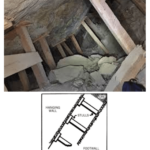Underground Mining Methods
Raman Kumar Biswas, Ph.D.
Professor
Dept. of Disaster Resilience and Engineering
Faculty of Environmental Science and Disaster Management, Patuakhali Science and Technology University Dumki-8602, Patuakhali.
Underground Mining Methods
DIFFERENT TYPES OF UNDERGROUND MINING METHODS
Learn More about the Lecture on Mine Development Process Lecture 1
Supported Underground Mining Methods
1) Cut and fill stopping
2) Stull stopping
3) Square set stopping
Unsupported Underground Mining Methods
1) Room and Pillar mining
(2) Stope-and-pillar mining
3) Shrinkage stopping
4) Sublevel stopping
Caving methods Underground Mining Methods
1) Longwall mining
2) Sublevel caving
3) Block Caving
Cut and Fill Stopping Underground Mining methods:
This method is used in vertical stops and in mining high-grade irregular ore bodies.
> The rock mass surrounding the ore deposit is usually a week
> Unable to support loads over an extended stoping height
> Successive cutting of the ore into horizontal slices is carried out starting from the bottom and progressing upwards towards the surface
> The ore is extracted in horizontal slices and replaced with backfill material
> The fill material varies, depending on the support required, and the material available
> It is one of the popular and expensive but selective mining methods, with low ore loss and dilution
> Is done only in high-grade minerals/resources
> Ore is drilled, blasted, and removed from the stope
> The ore is mined in slices
> Voids are backfilled with a variety of fill types to support the walls rock waste, tailings, sand, or other suitable materials
> In cut and fill stopping, the orebody is retrieved in horizontal slices beginning at the very bottom and advancing upwards towards the surface.
> Ramps (inclined tunnels) are excavated to connect the surface to the underground ore body.
> Drifts are excavated to come in contact with the ore slices, The slices are drilled using a jumbo, blasted by charging the drill holes with explosives, and ore is removed by using dump trucks or Load Haul Dump (LHD) vehicles.
> The ore is dumped into an ore pass, an inclined tunnel where ore is transported to a lower elevation in the mine.
> The ore is picked up at the other end of the ore pass by an LHD to be transported out of the mine through a ramp (inclined tunnel).
> Once a slice is completely mined out, the empty space is partially backfilled hydraulically.
> The backfill material used can be a mixture of sand and rocks, waste rock with cement, or dewatered mill tailings (rejected low-grade ore from processing, usually fine and sandy).
> The backfill underground serves to keep the mine walls stable and also as the floor for mining the next slice.
> Mining continues upwards towards the surface until the orebody is depleted.

Stull Stopping Underground Mining Methods:
>Stull stopping is a form of stopping.
> The depth of 3,500 feet (1,077 m) and at intervals up to 12 feet (3.7 m) wide
> Random timbering (“stulls”) placed between the foot and hanging wall of the vein.
>The 1893 mining disaster at Dolcoath mine in Cornwall was caused by the failure of the stulls holding up a huge weight of the waste rock.

What are the characteristics of Open-pit Mining?
>The deposits are relatively large, low grade, or shallow, with a sub-horizontal ore zone.
>The geology is lithology-controlled stockworks, disseminated zones.
>The resources are generally cost-effective to establish a 10 to 15-year resource/reserve life.
> The productivity is 5,000 to 100,000 tonnes per day.
>The environment has a large footprint from the pit, waste dumps, and tailings, relatively expensive to reclaim.
> The mine life is 10 to 25 years, rarely longer.
What is the basic difference between Underground Mining methods and Open-pit Mining Methods?
The deposits: The deposits are relatively small, high-grade, or deep with a sub-vertical ore zone in Underground Mining methods whereas in Open-pit Mining Methods The deposits are relatively large, low-grade, or shallow with a sub-horizontal ore zone.
Geology; Structurally controlled veins and breccias in Underground Mining methods whereas in Open-pit Mining Methods, lithology-controlled stockworks, and disseminated zones.
Resources/ Reserves: Generally difficult or not cost-effective to prove up large resources/reserves in Underground Mining methods whereas in open-pit mining methods generally cost-effective to establish a 10 to 15-year resource/ reserve life.
Productivity: 500 to 8,000 tonnes per day in Underground Mining methods whereas in the open-pit mining methods 5000 to 100000 tonnes per day.
Environmental condition: Generally easier to permit, limited footprint. Relatively cheap to reclaim in Underground Mining methods whereas in open-pit mining methods large footprint from the pit, waste dumps, and tailings, is relatively expensive to reclaim.
Mine Life:> 100 years in Underground Mining methods whereas in the open-pit mining methods 10 to 25 years, rarely longer.
Summary of Underground Mining methods and Open-pit Mining Methods
